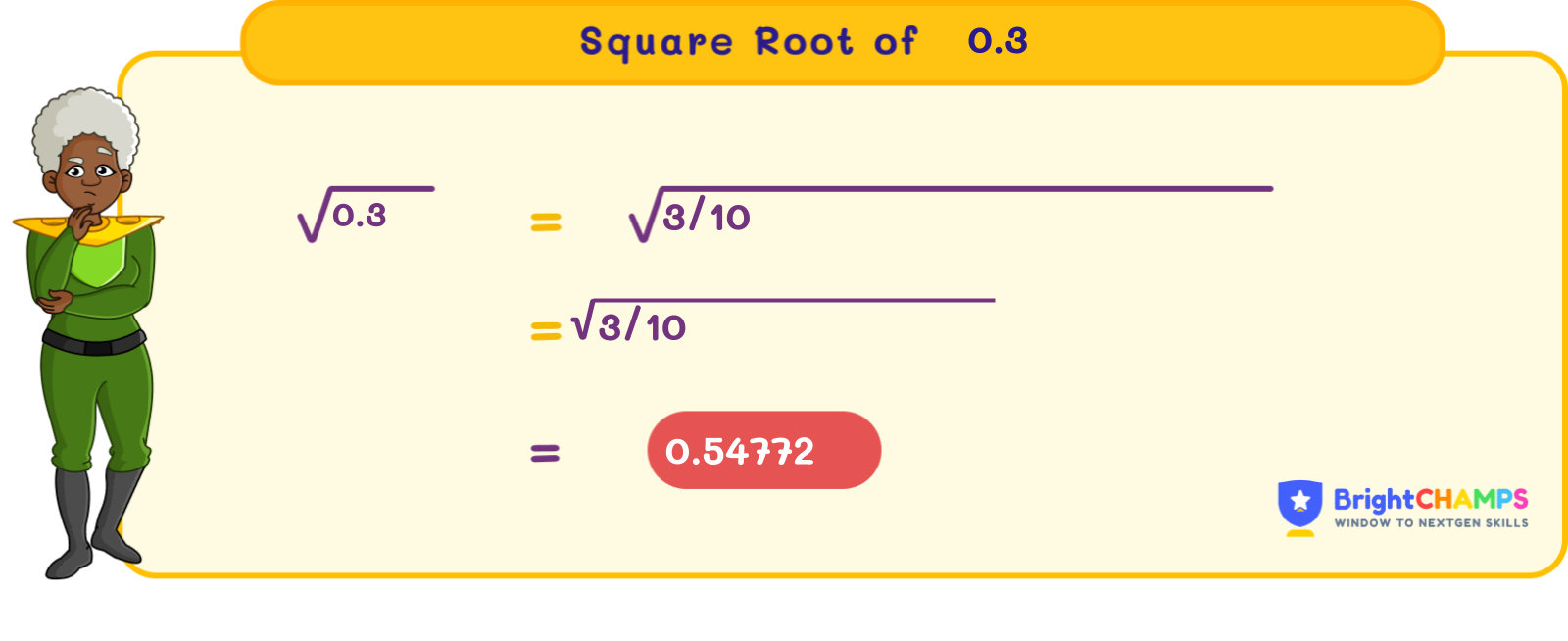![]() Table Of Contents
Table Of Contents

 101 Learners
101 LearnersLast updated on April 7th, 2025

Square Root of 0.3

If a number is multiplied by the same number, the result is a square. The inverse of the square is a square root. The square root is used in fields such as vehicle design and finance. Here, we will discuss the square root of 0.3.
What is the Square Root of 0.3?
The square root is the inverse of the square of a number. 0.3 is not a perfect square. The square root of 0.3 is expressed in both radical and exponential form. In the radical form, it is expressed as √0.3, whereas in the exponential form it is (0.3)(1/2). √0.3 ≈ 0.54772, which is an irrational number because it cannot be expressed in the form of p/q, where p and q are integers and q ≠ 0.

Finding the Square Root of 0.3
The prime factorization method is used for perfect square numbers. However, for non-perfect squares like 0.3, methods such as the long-division method and approximation method are used. Let us now learn the following methods:
- Long division method
- Approximation method
Square Root of 0.3 by Long Division Method
The long division method is particularly used for non-perfect square numbers. In this method, we find the square root step by step. Let us now learn how to find the square root of 0.3 using the long division method:
Step 1: To begin with, convert 0.3 to 30 by moving the decimal point two places to the right.
Step 2: Find n whose square is less than or equal to 30. We can say n is 5 because 5 x 5 = 25 is less than 30. The quotient is 5.
Step 3: Subtract 25 from 30, the remainder is 5. Bring down two zeros to make the new dividend 500.
Step 4: Double the quotient (5) to get 10, which will be our new divisor. Find the value of n such that 10n x n is less than or equal to 500. Let n be 4, so 104 x 4 = 416.
Step 5: Subtract 416 from 500, the remainder is 84. Bring down two more zeros to make the new dividend 8400.
Step 6: Continue the process until the desired decimal accuracy is achieved.
So, the square root of √0.3 ≈ 0.54772.
Square Root of 0.3 by Approximation Method
The approximation method is another method for finding square roots. It is an easy method to find the square root of a given number. Let us learn how to find the square root of 0.3 using the approximation method.
Step 1: Now we have to find the closest perfect squares around 0.3. The smallest perfect square is 0.25 (0.5²) and the largest perfect square is 0.36 (0.6²). √0.3 falls somewhere between 0.5 and 0.6.
Step 2: Apply linear interpolation between 0.5 and 0.6.
Using the formula: (0.3 - 0.25) / (0.36 - 0.25)
≈ 0.5 0.5 + 0.5(0.6 - 0.5)
= 0.55
Through interpolation, we find that √0.3 ≈ 0.54772.

Common Mistakes and How to Avoid Them in the Square Root of 0.3

Square root of 0.3 Examples

Problem 1
Can you help Max find the area of a square box if its side length is given as √0.3?

Explanation

Problem 2
A square-shaped building measures 0.3 square meters; if each of the sides is √0.3, what will be the square meters of half of the building?

Explanation

Problem 3
Calculate √0.3 x 5.

Explanation

Problem 4
What will be the square root of (0.25 + 0.05)?

Explanation

Problem 5
Find the perimeter of the rectangle if its length ‘l’ is √0.3 units and the width ‘w’ is 3 units.

Explanation


FAQ on Square Root of 0.3
1.What is √0.3 in its simplest form?
2.Is 0.3 a perfect square?
3.Calculate the square of 0.3.
4.Is 0.3 a rational number?
5.What is the decimal representation of √0.3?
Important Glossaries for the Square Root of 0.3
- Square root: A square root is the inverse of a square. Example: 4² = 16, and the inverse of the square is the square root, that is, √16 = 4.
- Irrational number: An irrational number is a number that cannot be written in the form of p/q, where q is not equal to zero and p and q are integers.
- Decimal: If a number has a whole number and a fraction in a single number, then it is called a decimal, for example, 0.3, 7.86, 8.65, and 9.42.
- Rational number: A rational number is a number that can be expressed in the form of a fraction p/q, where q is not zero and p and q are integers.
- Long division method: A method used to find the square root of non-perfect squares by dividing and finding the quotient step by step.
Explore More algebra
 Previous to Square Root of 0.3
Previous to Square Root of 0.3


Jaskaran Singh Saluja
About the Author
Jaskaran Singh Saluja is a math wizard with nearly three years of experience as a math teacher. His expertise is in algebra, so he can make algebra classes interesting by turning tricky equations into simple puzzles.

Fun Fact
: He loves to play the quiz with kids through algebra to make kids love it.




